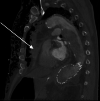Thoracic Aortic Rupture Post Cardiopulmonary Resuscitation in a Patient With Previous Thoracic Aneurysm Repair
- PMID: 37519602
- PMCID: PMC10373433
- DOI: 10.7759/cureus.41027
Thoracic Aortic Rupture Post Cardiopulmonary Resuscitation in a Patient With Previous Thoracic Aneurysm Repair
Abstract
Aortic dissection is characterized by a tear or rupture in the intimal layer of the aorta causing blood to flow between the layers of the arterial wall, thus separating them. While cardiopulmonary resuscitation (CPR) is a life-saving intervention, it can unintentionally contribute to the development or worsening of aortic dissection. The forceful chest compressions involved in CPR can put significant pressure on the fragile aortic wall, potentially leading to a tear or rupture. This highlights the delicate balance between life-saving measures and the potential risks they carry. Though studies have been done on the effects of CPR on the thoracic wall, few reports have studied the effects on the structures that lie in the thoracic cavity. The authors present a 63-year-old with a history of thoracic aneurysm repair who experienced a cardiac arrest while choking on food at home. The patient received CPR and a CT scan done thereafter revealed thoracic dissection and rupture. The patient received medical management in the Intensive Care Unit but eventually expired due to irreversible neurological damage. This highlights the importance of recognizing that CPR can pose a risk for aortic dissection and rupture, particularly in individuals with prior aortic repairs. It emphasizes the need for developing protocols to monitor patients who have undergone aneurysmal repair and adjusting CPR techniques to suit their specific needs. Additionally, further studies are needed to understand how often aortic complications occur after CPR and to provide guidance for follow-up care in patients who have had aortic repairs. By implementing these measures, we can improve outcomes and safety during resuscitation.
Keywords: cardiopulmonary resucitation; computed tomography scan; thoracic aortic aneurysm; thoracic aortic aneurysm repair; thoracic aortic dissection; thoracic aortic rupture.
Copyright © 2023, Etuk et al.
Conflict of interest statement
The authors have declared that no competing interests exist.
Figures
References
-
- Part 3: Adult basic life support and automated external defibrillation: 2015 international consensus on cardiopulmonary resuscitation and Emergency Cardiovascular Care science with Treatment Recommendations. Perkins GD, Travers AH, Berg RA, et al. Resuscitation. 2015;95:0–69. - PubMed
-
- Left ventricular rupture following external chest compression. Fosse E, Lindberg H. Acta Anaesthesiol Scand. 1996;40:502–504. - PubMed
-
- Goyal A, Sciammarella JC, Cusick AS, Patel PH. Cardiopulmonary Resuscitation. Treasure Island, FL: StatPearls Publishing; 2022. - PubMed
-
- Impact of bystander-initiated cardiopulmonary resuscitation for out-of-hospital cardiac arrest: where would you be happy to have a cardiac arrest? Giacoppo D. Eur Heart J. 2019;40:319–321. - PubMed
-
- Frequent and rare complications of resuscitation attempts. Buschmann CT, Tsokos M. Intensive Care Med. 2009;35:397–404. - PubMed
Publication types
LinkOut - more resources
Full Text Sources



